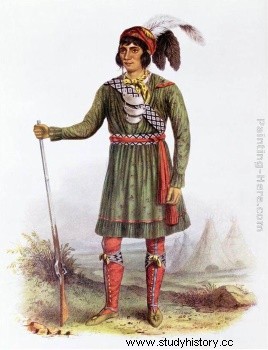
The Seminoles are a Native American people of North America. They now reside in Florida, where they are from, and Oklahoma.
The Seminole nation emerged in the 18th century; it was made up of Indians from the present-day states of Georgia, Mississippi, Alabama, and Florida, most often from the Creek nation but also African Americans fleeing slavery from Georgia (see Black Seminoles) . While about 3,000 Seminoles were deported west of the Mississippi River, including the Seminole Nation of Oklahoma, which gained new members on the journey, 300 to 500 Seminoles remained and fought in and around the Florida Everglades. 1,500 United States soldiers died in a series of three wars against the Seminoles of Florida, but no formal peace treaty was imposed on them or even offered, so they never surrendered to the United States government. This is why the Seminoles of Florida call themselves "the undefeated people".
Their current name is a deformation of the word Mvskoke (a Creek language) simano-li, itself an adaptation of the Spanish cimarrón, which means "wild", "runaway".
The pilot Willis bequeathed to the N.124 his personal insignia, that of a Seminole chief. The "head of Sioux" became, in April 1917, the official emblem of the Escadrille La Fayette.
Today, the Seminoles have sovereignty over their tribal lands; their economy is based on tobacco, tourism, and gambling. "Seminoles" is also the nickname for Florida State University sports teams.
History
After the Spanish conquest in the 16th century, the natives of Florida were decimated by disease and the few survivors are thought to have been evacuated by the Spanish to Cuba when Florida came under British control in 1763. P>
In the early 18th century, members of the Creek Nation from the lower towns began emigrating to Florida to break free from upper town Creek rule and mixed with the few native people who lived there, including the Yuchis, Yamasses and some other natives. They were then called "Seminoles", a derivative of the word "cimarrón" which means "wild" (in their case "wild men") in Spanish. The Seminoles were a heterogeneous tribe made up mostly of Lower Creek Georgia, Mikasuki-speaking Musckogee, and escaped enslaved African Americans, and to a lesser extent white Americans and Indians from other tribes.
The Unified Seminoles spoke two languages, Creek and Mikasuki (a modern dialect of Hitchiti), two different members of the Muskogean family, a language group that also includes Choctaw and Chickasaw. It is largely for these linguistic reasons that the current Miccosukee tribe of Florida maintains its singular identity. The Seminoles apparently lived on good terms with the Spaniards and the English. In 1784, the treaty that ended the American Revolutionary War returned Florida to Spanish control. However, the decline of the Spanish Empire allowed the Seminoles to settle deeper into the Florida swamps.
Until a majority of Seminoles were forced to move to Indian Territory (now Oklahoma) after the Second Seminole War.
